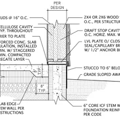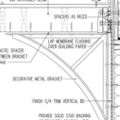Vapor Control With LP SmartSide Panels
I have a large shed which will be converted to a shop studio. It is sided with primed and painted thin (approx 3/8″) LP smartside panels as siding and sheathing. I can’t get a straight answer as to if the panels are considered impermeable and I will have to plan for drying to the interior or if they will dry exteriorly. There is a permeable house wrap between the panels and the studs. Can I use rigid foam for insulation between the studs using “cut and cobble ” technique? what type of rigid foam is permeable enough to will allow drying to the interior. Or do I need to go with fiberglass batts or cellulose to allow drying in that direction?thanks
GBA Detail Library
A collection of one thousand construction details organized by climate and house part










Replies
What is your climate zone?
"Wood, vinyl, and composite siding aren’t reservoir claddings, making inward vapor drive less important, but a drainage space or material prevents moisture accumulation behind the siding and helps protect the wall, even if not required by code. Note that some sidings may not qualify as a vented cladding without a back-vented air space." --Take a look at the attached resource.
Thank you for your response and the article. I'm in Climate Zone 6. Don't want to create a double vapor barrier, so wondering if the smartsiding panels are impermeable enough to act in that way if combined with rigid air-sealed foam used in the stud cavities as insulation. If the panels are more permeable then I have less apprehension about using the foam.